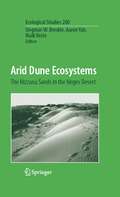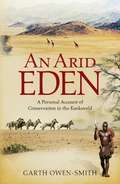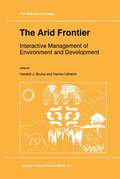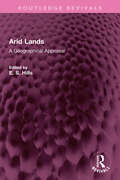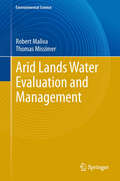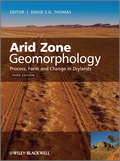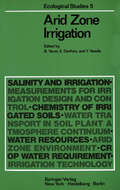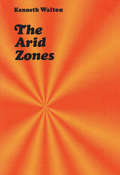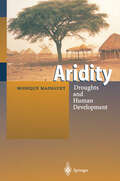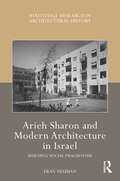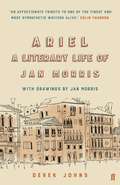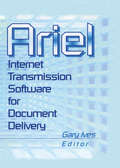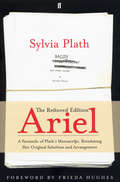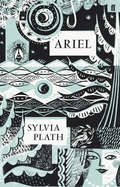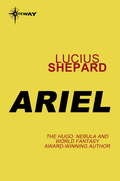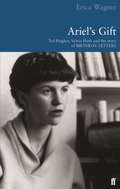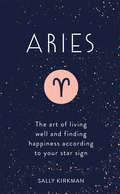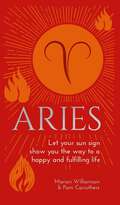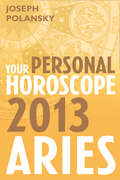- Table View
- List View
Arid Dune Ecosystems: The Nizzana Sands in the Negev Desert (Ecological Studies #200)
by Siegmar-W. Breckle Aaron Yair Maik VesteSand dune dynamics play a key role in many arid deserts. This volume provides a thorough analysis of a specific sand dune ecosystem, the Nizzana site in the Middle East’s Negev Desert. Describing its climate, as well as its geophysical/geochemical soil properties and ecology, this brilliant work draws out the relationships between the site’s ecological and geomorphological processes, based on long-term monitoring, in situ experiments and satellite imagery.
An Arid Eden: A Personal Account Of Conservation In The Kaokoveld
by Garth Owen-SmithTwo remarkable tales woven together - the story of the Kaokoveld, an arid eden in the remote north-west of Namibia, so nearly lost, but regained to become one of Africa's iconic wildlife tourism destinations, and also the story of a young man's search for an African way to do conservation in Africa. Garth Owen-Smith first visited the Kaokoveld in 1967. It was a life-changing experience. His unconventional ideas challenged both the conservation establishment and the former South African regime. Despite this, community-based conservation was pioneered in the Kaokoveld and today Namibia is a world leader in this field. But the early years - when the foundation for this ground-breaking approach to conservation was laid - are largely forgotten and untold. An Arid Eden: A Personal Account of Conservation in the Kaokoveld brings those years alive through the eyes of Owen-Smith, spanning four-and-a-half decades of extraordinary dedication, passion and achievement. The author and his partner Dr Margaret Jacobsohn have won some of the world's most prestigious conservation awards for their work in Namibia, which has always challenged convential wisdom. The NGO they founded continues to break conservation, agricultural and rural development paradigms.
The Arid Frontier: Interactive Management of Environment and Development (GeoJournal Library #41)
by Hendrik J. Bruins Harvey LithwickThe arid frontier has been a challenge for humanity from time immemorial. Drylands cover more than one-third of the global land surface, distributed over Africa, Asia, Australia, America and Southern Europe. Disasters may develop as a result of complex interactions between drought, desertification and society. Therefore, proactive planning and interactive management, including disaster-coping strategies, are essential in dealing with arid-frontier development. This book presents a conceptual framework with case studies in dryland development and management. The option of a rational and ethical discourse for development that is beneficial for both the environment and society is emphasized, avoiding extreme environmentalism and human destructionism, combating both desertification and human livelihood insecurity. Such development has to be based on appropriate ethics, legislation, policy, proactive planning and interactive management. Excellent scholars address these issues, focusing on the principal interactions between people and dryland environments in terms of drought, food, land, water, renewable energy and housing. Audience: This volume will be of great value to all those interested in Dryland Development and Management: professionals and policy-makers in governmental, international and non-governmental organizations (NGOs), as well as researchers, lecturers and students in Geography, Environmental Management, Regional Studies, Development Anthropology, Hazard and Disaster Management, Agriculture and Pastoralism, Land and Water Use, African Studies, and Renewable Energy Resources.
Arid Lands: A Geographical Appriasal (Routledge Revivals)
by E. S. HillsIn 1951 UNESCO launched an Arid Zone Programme with the object of promoting research into arid regions from every relevant scientific point of view. This book, originally published in 1966, represents the range of research undertaken and gives a general conspectus of arid zone geography. 17 authors from 8 countries contributed and the book deals comprehensively with all the main areas, with specific examples used to illustrate arguments. There are chapters on meteorology, geology, geomorphology, botany and zoology and almost 50% of the book is devoted to man’s activities: irrigation and agriculture; industry; animal breeding and human survival in the desert
Arid Lands: A Geographical Appriasal (Routledge Revivals)
In 1951 UNESCO launched an Arid Zone Programme with the object of promoting research into arid regions from every relevant scientific point of view. This book, originally published in 1966, represents the range of research undertaken and gives a general conspectus of arid zone geography. 17 authors from 8 countries contributed and the book deals comprehensively with all the main areas, with specific examples used to illustrate arguments. There are chapters on meteorology, geology, geomorphology, botany and zoology and almost 50% of the book is devoted to man’s activities: irrigation and agriculture; industry; animal breeding and human survival in the desert
Arid Lands Water Evaluation and Management (Environmental Science and Engineering)
by Robert Maliva Thomas MissimerA large part of the global population lives in arid lands which have low rainfall and often lack the water required for sustainable population and economic growth. This book presents a comprehensive description of the hydrogeology and hydrologic processes at work in arid lands. It describes the techniques that can be used to assess and manage the water resources of these areas with an emphasis on groundwater resources, including recent advances in hydrologic evaluation and the differences between how aquifer systems behave in arid lands versus more humid areas. Water management techniques are described and summarized to show how a more comprehensive approach to water management is required in these areas, including the need to be aware of cultural sensitivities and conditions unique to many arid regions. The integration of existing resources with the addition of new water sources, such as desalination of brackish water and seawater, along with reusing treated wastewater, will be required to meet future water supply needs. Also, changing climatic conditions will force water management systems to be more robust so that future water supply demands can be met as droughts become more intense and rainfall events become more intense. A range of water management techniques are described and discussed in order to illustrate the methods for integrating these measures within the context of arid lands conditions.
Arid Zone Geomorphology: Process, Form and Change in Drylands
by David S. G. ThomasThe new edition of Arid Zone Geomorphology aims to encapsulate the advances that have been made in recent years in the investigation and explanation of landforms and geomorphological processes in drylands. Building on the success of the previous two editions, the Third Edition has been completely revised and updated to reflect the latest developments in the field. Whilst this latest edition will remain a comprehensive reference to the subject, the book has been restructured to include regional case studies throughout to enhance student understanding and is clearly defined into five distinct sections; Firstly, the book introduces the reader to Large Scale Controls and Variability in Drylands and then moves on to consider Surface Processes and Characteristics; The Work of Water, The Work of the Wind. The book concludes with a section on Living with Dryland Geomorphology that includes a chapter on geomorphological hazards and the human impact on these environments. Once again, recognised world experts in the field have been invited to contribute chapters in order to present a comprehensive and up-to-date overview of current knowledge about the processes shaping the landscape of deserts and arid regions. In order to broaden the appeal of the Third Edition, the book has been reduced in extent by 100 pages and the Regional chapters have been omitted in favour of the inclusion of key regional case studies throughout the book. The Editor is also considering the inclusion of a supplementary website that could include further images, problems and case studies.
Arid Zone Geomorphology: Process, Form and Change in Drylands
by David S. G. ThomasThe new edition of Arid Zone Geomorphology aims to encapsulate the advances that have been made in recent years in the investigation and explanation of landforms and geomorphological processes in drylands. Building on the success of the previous two editions, the Third Edition has been completely revised and updated to reflect the latest developments in the field. Whilst this latest edition will remain a comprehensive reference to the subject, the book has been restructured to include regional case studies throughout to enhance student understanding and is clearly defined into five distinct sections; Firstly, the book introduces the reader to Large Scale Controls and Variability in Drylands and then moves on to consider Surface Processes and Characteristics; The Work of Water, The Work of the Wind. The book concludes with a section on Living with Dryland Geomorphology that includes a chapter on geomorphological hazards and the human impact on these environments. Once again, recognised world experts in the field have been invited to contribute chapters in order to present a comprehensive and up-to-date overview of current knowledge about the processes shaping the landscape of deserts and arid regions. In order to broaden the appeal of the Third Edition, the book has been reduced in extent by 100 pages and the Regional chapters have been omitted in favour of the inclusion of key regional case studies throughout the book. The Editor is also considering the inclusion of a supplementary website that could include further images, problems and case studies.
Arid Zone Irrigation (Ecological Studies #5)
by Bruno Yaron Erik Danfors Y. VaadiaA book previously published within the framework of the Ecological Studies Series, entitled "Physical Aspects of Soil Water and Salts in Ecosystems" included awidespectrum of research papers devoted to new findings in the field of soil-plant-water relationships. "Arid Zone Irrigation" has been written specifically as a textbook for agronomists, soil scientists, agrometeorologists, water engineers and plant physiologists who want a clear presentation of irrigation fundamentals in arid and semi-arid zones. It was our intention to provide an understanding of the basic principles governing irrigation technology and to help overcome the problem of water shortage in arid zone agriculture. This book, written by a large number of specialists and covering a broad spectrum of different disciplines, is based on general up-to-date information, as well as on the results of the authors' own research. The idea of preparing such a textbook was conceived during a series of international advanced courses on irrigation held annually at the Institute of Soils and Water, Agricul tural Research Organization, Volcani Center, Bet Dagan, Israel. The final organization of the material has been influenced by discussions with colleagues from Sweden and Holland and the participants in our summer courses. Grateful acknowledgements are due to Professor CALVIN C. ROSE, CSIRO, Canberra, Australia, Professor DALE SWARTZENDRUBER, Purdue University, Lafayetta, U.S.A., and Dr. SHLOMO P. NEUMAN, Agricultural Research Organization, Bet Dagan, Israel, for their many helpful suggestions during critical reading of the manuscript. We thank also Mrs.
The Arid Zones
by Hilton KramerThe hot and temperate deserts and their marginal steppe lands comprise one-third of the land surface of the world and are an increasingly critical area for the economic wellbeing of world populations. The remarkable mechanisms of floral, faunal, and human adaptation to the distinct and difficult environment of these arid zones, as well as the potential of modern technology for facilitating adaptation, are described and explained by Walton in the light of our most recent knowledge of the phenomena and processes involved.Beginning with a clarification of the definitions of arid and semi-arid regions and with the delineation of techniques for measuring the degree of aridity in these areas, the author shows that there is wide variation among the arid zones in landscape and climate and that there are numerous local and microclimates within any single arid region. The life cycles of the plants and animals of the arid zones are described and the water resources, including problems of salinity, mineral contamination, and the construction of reservoirs, are examined. Extensive treatment is given to potential agricultural adaptations and to pastoralism as the most widespread response to dry land. A final chapter summarizes attempts at adaptation to prevailing drought and discusses the kinds of future development that the author deems most likely in arid zones.Throughout the book emphasis is placed on specific, detailed analysis, with adequate tables and formulas for in-depth understanding of particular aspects of aridity. Examples from both Old and New Worlds are used to demonstrate the spheres in which progress is being made and to show the mistakes in past and present land use in arid areas. An essential supplement for courses in physical geography, the book will be useful in many area studies and in studies of economic development.
The Arid Zones
by Hilton KramerThe hot and temperate deserts and their marginal steppe lands comprise one-third of the land surface of the world and are an increasingly critical area for the economic wellbeing of world populations. The remarkable mechanisms of floral, faunal, and human adaptation to the distinct and difficult environment of these arid zones, as well as the potential of modern technology for facilitating adaptation, are described and explained by Walton in the light of our most recent knowledge of the phenomena and processes involved.Beginning with a clarification of the definitions of arid and semi-arid regions and with the delineation of techniques for measuring the degree of aridity in these areas, the author shows that there is wide variation among the arid zones in landscape and climate and that there are numerous local and microclimates within any single arid region. The life cycles of the plants and animals of the arid zones are described and the water resources, including problems of salinity, mineral contamination, and the construction of reservoirs, are examined. Extensive treatment is given to potential agricultural adaptations and to pastoralism as the most widespread response to dry land. A final chapter summarizes attempts at adaptation to prevailing drought and discusses the kinds of future development that the author deems most likely in arid zones.Throughout the book emphasis is placed on specific, detailed analysis, with adequate tables and formulas for in-depth understanding of particular aspects of aridity. Examples from both Old and New Worlds are used to demonstrate the spheres in which progress is being made and to show the mistakes in past and present land use in arid areas. An essential supplement for courses in physical geography, the book will be useful in many area studies and in studies of economic development.
Aridity: Droughts and Human Development
by Monique MainguetAt the intersection of environmental science and human biology, this book deals with dry ecosystems, the societies so affected, and the inventiveness of those living under such conditions. It also tries to answer the question of whether long-lasting development is possible in dry environments.
Arieh Sharon and Modern Architecture in Israel: Building Social Pragmatism (Routledge Research in Architectural History)
by Eran NeumanArieh Sharon and Modern Architecture in Israel: Building Social Pragmatism offers the first comprehensive survey of the work of Arieh Sharon and analyzes and discusses his designs and plans in relation to the emergence of the State of Israel. A graduate of the Bauhaus, Sharon worked for a few years at the office of Hannes Mayer before returning to Mandatory Palestine. There, he established his office which was occupied in its first years in planning kibbutzim and residential buildings in Tel Aviv. After the establishment of the State of Israel in 1948, Arieh Sharon became the director and chief architect of the National Planning Department, where he was asked to devise the young country’s first national masterplan. Known as the Sharon Plan, it was instrumental in shaping the development of the new nation. During the 1950s and 1960s, Sharon designed many of Israel’s institutions, including hospitals and buildings on university campuses. This book presents Sharon’s exceptionally wide range of work and examines his perception of architecture in both socialist and pragmatist terms. It also explores Sharon’s modernist approach to architecture and his subsequent shift to Brutalist architecture, when he partnered with Benjamin Idelson in the 1950s and when his son, Eldar Sharon, joined the office in 1964. Thus, the book contributes a missing chapter in the historiography of Israeli architecture in particular and of modern architecture overall. This book will be of interest to researchers in architecture, modern architecture, Israel studies, Middle Eastern studies and migration of knowledge.
Arieh Sharon and Modern Architecture in Israel: Building Social Pragmatism (Routledge Research in Architectural History)
by Eran NeumanArieh Sharon and Modern Architecture in Israel: Building Social Pragmatism offers the first comprehensive survey of the work of Arieh Sharon and analyzes and discusses his designs and plans in relation to the emergence of the State of Israel. A graduate of the Bauhaus, Sharon worked for a few years at the office of Hannes Mayer before returning to Mandatory Palestine. There, he established his office which was occupied in its first years in planning kibbutzim and residential buildings in Tel Aviv. After the establishment of the State of Israel in 1948, Arieh Sharon became the director and chief architect of the National Planning Department, where he was asked to devise the young country’s first national masterplan. Known as the Sharon Plan, it was instrumental in shaping the development of the new nation. During the 1950s and 1960s, Sharon designed many of Israel’s institutions, including hospitals and buildings on university campuses. This book presents Sharon’s exceptionally wide range of work and examines his perception of architecture in both socialist and pragmatist terms. It also explores Sharon’s modernist approach to architecture and his subsequent shift to Brutalist architecture, when he partnered with Benjamin Idelson in the 1950s and when his son, Eldar Sharon, joined the office in 1964. Thus, the book contributes a missing chapter in the historiography of Israeli architecture in particular and of modern architecture overall. This book will be of interest to researchers in architecture, modern architecture, Israel studies, Middle Eastern studies and migration of knowledge.
Ariel: A Literary Life of Jan Morris
by Derek JohnsJan Morris is one of the great British writers of the post-war era. Soldier, journalist, writer about places (rather than 'travel writer'), elegist of the British Empire, novelist, she has fashioned a distinctive prose style that is elegant, fastidious, supple, and sometimes gloriously gaudy. For many readers she is best known for her candid memoir Conundrum, which described the gender reassignment operation she underwent in 1972. But as Ariel demonstrates, this is just one of the many remarkable facts about her life. As James Morris she was the journalist who brought back the story of the conquest of Everest in 1953 and who discovered incontrovertible evidence of British involvement in the Suez Crisis of 1956. She has been described by Rebecca West as the finest prose stylist of her time, and her essays span the entire urban world. Her many books include a classic on Venice, a 1,600 page history of the British Empire, and a homage to what is perhaps her favourite city, Trieste. Her writings on Wales represent the most thorough literary investigation of that mysterious land.Derek Johns was Jan Morris's literary agent for twenty years. Ariel is not a conventional biography, but rather an appreciation of the work and life of someone who besides being a delightful writer is known to many people as a generous, affectionate, witty and irreverent friend. It is published to coincide with her 90th birthday.
Ariel: Internet Transmission Software for Document Delivery
by Leslie R Morris Gary W IvesSupplement traditional interlibrary loan programs with this speedy document delivery system! Since its introduction in 1991, the Ariel system has transformed the interlibrary loan of documents. Compared to standard interlibrary loan, Ariel is often simpler, faster, and cheaper, and it allows many users at a time to have access to requested documents. Though Ariel has enjoyed a rapidly increasing user base, Ariel: Internet Transmission Software for Document Delivery is the first book dedicated to Ariel and the experiences of libraries using it. Ariel: Internet Transmission Software for Document Delivery provides practical details on this innovative technology, including clear discussions of how the system works. The software manages the process of scanning requested documents, transmitting them between libraries and document suppliers over high-speed Internet connections, and logging their receipt. Ariel discusses the pros and cons of various delivery options, including Web-based delivery, email, and delivery of laser-printed hard copy by hand, mail, or courier service. This comprehensive volume covers all aspects of adopting and using Ariel, including: training library staff and overcoming their resistance patron needs and response choosing scanners and other equipment setting up consortia to share Ariel files copyright issues international use of Ariel enhancing the system to suit your needsLike its Shakespearean namesake, the Ariel system darts through the air to rapidly fetch what someone needs. Ariel: Internet Transmission Software for Document Delivery gives you the solid data you need to get the most out of Ariel.
Ariel: Internet Transmission Software for Document Delivery
by Leslie R Morris Gary W IvesSupplement traditional interlibrary loan programs with this speedy document delivery system! Since its introduction in 1991, the Ariel system has transformed the interlibrary loan of documents. Compared to standard interlibrary loan, Ariel is often simpler, faster, and cheaper, and it allows many users at a time to have access to requested documents. Though Ariel has enjoyed a rapidly increasing user base, Ariel: Internet Transmission Software for Document Delivery is the first book dedicated to Ariel and the experiences of libraries using it. Ariel: Internet Transmission Software for Document Delivery provides practical details on this innovative technology, including clear discussions of how the system works. The software manages the process of scanning requested documents, transmitting them between libraries and document suppliers over high-speed Internet connections, and logging their receipt. Ariel discusses the pros and cons of various delivery options, including Web-based delivery, email, and delivery of laser-printed hard copy by hand, mail, or courier service. This comprehensive volume covers all aspects of adopting and using Ariel, including: training library staff and overcoming their resistance patron needs and response choosing scanners and other equipment setting up consortia to share Ariel files copyright issues international use of Ariel enhancing the system to suit your needsLike its Shakespearean namesake, the Ariel system darts through the air to rapidly fetch what someone needs. Ariel: Internet Transmission Software for Document Delivery gives you the solid data you need to get the most out of Ariel.
Ariel: A Facsimile Of Plath's Manuscript, Reinstating Her Original Selection And Arrangement (P. S. Ser.)
by Sylvia PlathUpon the publication of her posthumous volume of poetry Ariel in 1965, Sylvia Plath became a household name. Readers may be surprised to learn that the draft of Ariel left behind by Plath when she died in 1963 is different from the volume of poetry eventually published to worldwide acclaim.This facsimile edition restores, for the first time, the selection and arrangement of the poems Sylvia Plath left at the point of her death. In addition to the facsimile pages of Sylvia Plath's manuscript, this edition also includes in facsimile the complete working drafts of the title poem 'Ariel' in order to offer a sense of Plath's creative process, as well as notes the author made for the BBC about some of the manuscript's poems, including 'Daddy' and 'Lady Lazarus'In her insightful foreword to this volume, Frieda Hughes, Sylvia Plath's daughter, explains the reasons for the differences between the previously published edition of Ariel as edited by her father, Ted Hughes, and her mother's original version published here. With this publication, Sylvia Plath's legacy and vision will be reevaluated in the light of her original working draft.
Ariel: A Facsimile Of Plath's Manuscript, Reinstating Her Original Selection And Arrangement (Poesia Hiperion Ser.)
by Sylvia PlathThe poems in Sylvia Plath's Ariel, including many of her best-known such as 'Lady Lazarus', 'Daddy', 'Edge' and 'Paralytic', were all written between the publication in 1960 of Plath's first book, The Colossus, and her death in 1963. 'If the poems are despairing, vengeful and destructive, they are at the same time tender, open to things, and also unusually clever, sardonic, hardminded . . . They are works of great artistic purity and, despite all the nihilism, great generosity . . . the book is a major literary event.' A. Alvarez in the ObserverThis beautifully designed edition forms part of a series with five other cherished poets, including Wendy Cope, Don Paterson, Philip Larkin, Simon Armitage and Alice Oswald.
Ariel
by Lucius ShepardAriel brilliantly transmutes some traditional SF concepts - alien incursions, the mysteries of quantum physics - into an astonishing, often moving reflection on love and obsession, memory and identity, and the archetypal conflict that stands at the heart of an infinite multitude of worlds.
Ariel's Gift: Ted Hughes, Sylvia Plath And The Story Of Birthday Letters
by Erica WagnerErica Wagner provides a comprehensive guide to the poems that must constitute one of the most extraordinary and powerful volumes published in the last century. When Ted Hughes's Birthday Letters was published in 1998, it was greeted with astonishment and acclaim. Few suspected that Ted Hughes had been at work, for a quarter of a century, on a cycle of poems addressed almost entirely to his first wife, the American poet Sylvia Plath. In Ariel's Gift, Erica Wagner offers a commentary on the poems, pointing the reader towards the events that shaped them, and, crucially, showing how they draw upon Plath's own work.
Aries: The Art of Living Well and Finding Happiness According to Your Star Sign
by Sally KirkmanYou are an Aries. You are the pioneer and warrior of the zodiac.The signs of the zodiac can give us great insight into our day-to-day living as well as the many talents and qualities we possess. But in an increasingly unpredictable world, how can we make sense of them? And what do they mean? This insightful and introductory guide delves deep into your star sign, revealing unique traits and meanings which you didn't know. Along the way, you will discover how your sign defies your compatibility, how to improve your health and what your gifts are. ***The Pocket Astrology series will teach you how to live well and enhance every aspect of your life. From friendship to compatibility, careers to finance, you will discover new elements to your sign and learn about the ancient art of astrology. Other books in the series include: Aries, Taurus, Gemini, Cancer, Leo, Virgo, Libra, Scorpio, Sagittarius, Capricorn, Aquarius, Pisces
Aries (Planet Zodiac Ser.)
by Liberty PhiFrom ancient times, people have wanted to understand the rhythms of life and looked to the skies for answers. The Ancient Greeks and Romans turned to the celestial bodies for inspiration and devised narratives to which they referred to make decisions and choices. Maybe the options have changed, but we are still seeking wisdom and guidance in life today. Whether it's working out your ideal career, your perfect partner or to understand more about how you communicate, Liberty Phi has the answers.A student of astrology for over 20 years, in her Planet Zodiac series, Liberty will take you on a deep dive into your star sign and birth chart. Only by understanding the meaning, nature and power of each planet and how that's relevant to your birth chart – which is relevant only to you – can you really harness the power of the zodiac. You can then use this knowledge to work out how planetary patterns might influence you and how they will affect your life in a rather profound way. You will learn, for instance, what sort of impression you are likely to make when you enter a room, how you function in a group, or how spontaneous you are likely to be.Whatever your star sign, these books will help you to take an in-depth and tailored exploration of your star sign and will give you the tools to harness the zodiac and take control of your life.
Aries: Let Your Sun Sign Show You the Way to a Happy and Fulfilling Life (Arcturus Astrology Library)
by Marion Williamson Pam CarruthersWhat do the stars reveal about you, your personality, your gifts and challenges? Bestselling, highly regarded astrologers, Marion Williamson and Pam Carruthers, explain what your Sun and Moon signs say about you, as well as who you get along with in relationships and at work.In this guide you can find out which parts of the world resonate most with you for travel and what you should be doing to live at your highest potential. With insight into what your day of birth means for your personality as well as ideas to meditate on to bring further spiritual development, this is your one-stop guide to all things Aries.The astrology series of 12 books allows readers to deep dive into what their Sun sign, and birthchart, says about them. Including sections on personality insights, love compatibilities, best career and travel choices, moon signs, as well as analysis for exact dates of birth and the meanings of other planets in a birthchart, this is a far-ranging look at what the stars mean for us on Earth.
Aries 2013: Your Personal Horoscope
by Joseph PolanskyThe month-by-month forecast for people with birthdays between 21st March and 20th April. This book tells you all you need to know to find out what is in store for you in the year ahead.
